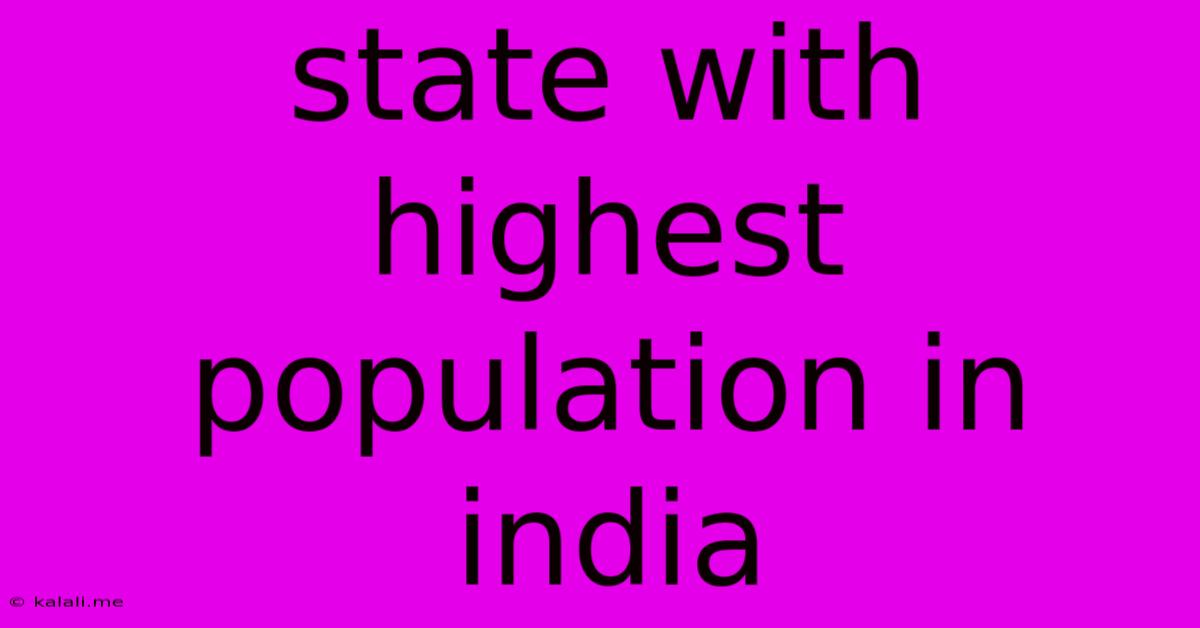State With Highest Population In India
Kalali
Jun 14, 2025 · 3 min read

Table of Contents
Uttar Pradesh: India's Most Populous State – A Demographic Deep Dive
Meta Description: Discover why Uttar Pradesh holds the title of India's most populous state, exploring its demographic makeup, contributing factors, and the implications of its immense population. Learn about its unique characteristics and challenges.
India, a land of incredible diversity, is home to the world's largest population. Within this vast nation, one state stands out: Uttar Pradesh. This article delves into the reasons behind Uttar Pradesh's significant population, examining its demographic profile, historical context, and the challenges and opportunities presented by its immense size.
Why Uttar Pradesh Holds the Top Spot
Uttar Pradesh consistently claims the title of India's most populous state, boasting a population exceeding 200 million people. This remarkable figure represents a significant portion of India's total population, highlighting its demographic weight within the country. Several factors contribute to this high population density:
-
High Birth Rate: Historically, Uttar Pradesh has had a relatively high birth rate compared to other Indian states. While birth rates are declining, the legacy of a large population base continues to impact overall numbers.
-
Extensive Fertility Rates: For a considerable period, fertility rates in Uttar Pradesh remained significantly higher than the national average. This has directly contributed to the state's substantial population growth.
-
Limited Access to Family Planning: While access to family planning services has improved, certain regions within Uttar Pradesh still face challenges in reaching all segments of the population with effective family planning education and resources.
-
Rural Population Density: A large percentage of Uttar Pradesh's population resides in rural areas, where traditional societal norms and limited access to healthcare can impact family planning practices.
-
Migration Patterns: While internal migration does occur, Uttar Pradesh hasn't experienced the same level of outward migration as some other states, contributing to population concentration within its borders.
Understanding the Demographic Landscape
The population of Uttar Pradesh is not homogenous. It's a complex tapestry of diverse communities, languages, and cultures. Analyzing its demographics is crucial for understanding its challenges and opportunities:
-
Age Distribution: The state exhibits a relatively young population, with a significant proportion of individuals below the age of 35. This presents both opportunities (a large working-age population) and challenges (the need for substantial investments in education and employment).
-
Gender Imbalance: Uttar Pradesh, like many parts of India, faces challenges related to gender imbalance. The sex ratio (number of females per 1000 males) is a key area requiring attention and policy interventions.
-
Literacy Rates: While literacy rates have been improving, the state still faces challenges in ensuring universal access to quality education, particularly for marginalized communities. This has significant implications for economic development and social progress.
-
Rural-Urban Divide: The significant disparity between rural and urban areas creates a complex development landscape, requiring targeted interventions for both segments of the population.
Implications and Challenges
The sheer size of Uttar Pradesh's population presents both significant challenges and opportunities:
-
Infrastructure Development: Meeting the demands of such a large population requires substantial investments in infrastructure, including housing, transportation, sanitation, and healthcare facilities.
-
Resource Management: Managing resources effectively, such as water and energy, is crucial to ensure sustainable development and prevent resource scarcity.
-
Employment Generation: Creating sufficient employment opportunities for the growing workforce is paramount to ensuring economic stability and reducing poverty levels.
-
Healthcare and Education: Investing in quality healthcare and education is critical to improving the well-being of the population and driving human capital development.
Conclusion
Uttar Pradesh's position as India's most populous state is a complex phenomenon with deep historical roots and far-reaching implications. Understanding its demographic landscape, including its challenges and opportunities, is critical for effective policy-making and sustainable development. Addressing the issues related to population growth, education, healthcare, and infrastructure will be crucial in unlocking the state's vast potential and ensuring a better future for its citizens.
Latest Posts
Latest Posts
-
Example For Open Loop Control System
Jun 14, 2025
-
A Portfolio Is A Collection Of
Jun 14, 2025
-
What Is The Study Of Spiders Called
Jun 14, 2025
-
Booting Is The Process Of Which Of The Following
Jun 14, 2025
-
Which Of The Following Is An Example Of A Solution
Jun 14, 2025
Related Post
Thank you for visiting our website which covers about State With Highest Population In India . We hope the information provided has been useful to you. Feel free to contact us if you have any questions or need further assistance. See you next time and don't miss to bookmark.